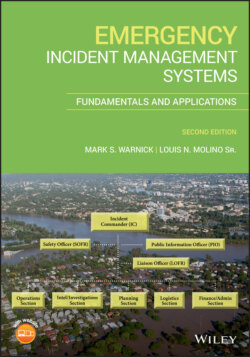Читать книгу Emergency Incident Management Systems - Mark Warnick S., Louis N. Molino Sr - Страница 2
Table of Contents
Оглавление1 Cover
2 Foreword
3 Preface
4 Acknowledgments
5 About the Book
6 About the Companion Website
7 1 Introduction 1.1 The Revolutionary War 1.2 The Big Burn of 1910 1.3 The Military Connection 1.4 The Birth of IMS Method 1.5 California's Solution 1.6 Creating the Incident Command System 1.7 Evolution of IMS Methods 1.8 The “Big Three” of IMS 1.9 The Melding of the IMS Concepts of Today 1.10 The National Incident Management System (NIMS) 1.11 Presidential Directives 1.12 The NIMS Mandate 1.13 NIMS Updates/Changes (2008) and Training 1.14 NIMS Updates (2017) 1.15 Conclusion
8 2 A Case Study of Incident Management 2.1 The Lifecycle of an Incident 2.2 Common Attributes of an Incident 2.3 The Importance of Knowledge and Experience 2.4 Case Study: Tokyo Versus Oklahoma City 2.5 Comparing and Contrasting These Incidents 2.6 Conclusion
9 3 Incident Management in Other Countries 3.1 The United Nations 3.2 Australia 3.3 Bermuda 3.4 Burma/Myanmar 3.5 Bangladesh 3.6 Brunei 3.7 Cambodia 3.8 Canada 3.9 China 3.10 Germany 3.11 Haiti 3.12 India 3.13 Indonesia 3.14 Iran 3.15 Iraq 3.16 Japan 3.17 Maldives 3.18 Malaysia 3.19 Mexico 3.20 New Zealand 3.21 Palestine 3.22 Philippine Islands 3.23 Russia 3.24 Singapore 3.25 United Kingdom 3.26 Vietnam 3.27 Other International Uses
10 4 The Five Cs of Crisis (or Incident) Management 4.1 Command 4.2 Control 4.3 Communications 4.4 Responder Communication Problems 4.5 Integrated Responder Communications 4.6 Creating a Communications Unit for Responders 4.7 Radio Networks 4.8 Stakeholder Communications 4.9 Communications Wrap‐up 4.10 Cooperation and Coordination 4.11 Cooperation and Coordination in the State of Illinois 4.12 Private Sector Cooperation and Coordination 4.13 Strengthening Intelligence/Information Sharing with Coordination and Cooperation 4.14 Cooperation and Coordination During an Active Incident 4.15 Conclusion
11 5 The National Incident Management System (NIMS) 5.1 NIMS Method Guiding Principles 5.2 Key Terms and Definitions 5.3 Understanding Comprehensive, Flexible, and Adaptable 5.4 NIMS Components 5.5 The Importance of Preparedness with NIMS 5.6 NIMS Method of Resource Management: Preparedness 5.7 NIMS Qualifying, Certifying, and Credentialing Personnel1 5.8 NIMS Method of Resource Management Response and Recovery1 5.9 NIMS Multiagency Coordination Systems1 5.10 Conclusion Notes
12 6 An Overview of the Incident Command System 6.1 Taking Control with ICS 6.2 Common Components of Incident Management Systems 6.3 ICS and NIMS‐Differences and Commonalities 6.4 Incident Management System and NIMS Integration 6.5 Conclusion
13 7 Command Staff, General Staff, and Their Functions 7.1 Incident Commander (IC) 7.2 Unified Command 7.3 Command Staff 7.4 General Staff 7.5 Expanding the Hierarchal Structure 7.6 Conclusion
14 8 Expanding the Operations Section 8.1 Operations Section 8.2 Conclusion Note
15 9 Expanding Logistics 9.1 Logistics Section Expansion Notes
16 10 Expanding Planning and Intelligence 10.1 Planning and Intelligence Modular Expansion Notes
17 11 Expanding Finance and Administration 11.1 Compensation Claim Unit 11.2 Cost Unit 11.3 Procurement Unit 11.4 Time Unit Note
18 12 ICS Investigations and Intelligence (I/I) 12.1 Historical Overview 12.2 More than Law Enforcement 12.3 Investigations and Intelligence Gathering (I/I) Information Sharing 12.4 Placement Consideration of Investigations and Intelligence Gathering (I/I) 12.5 Conclusion Note
19 13 The Agency Administrator, Common Agency Representatives, and a Basic Overview of the Planning Process 13.1 The Agency Administrator 13.2 Agency Administrator Representatives 13.3 An Overview of the ICS Planning Process Notes
20 14 Management by Objectives – SMART Goals 14.1 Underlying Factors for Determining Incident Objectives and Strategies 14.2 Establishing Immediate Incident Objective Priorities 14.3 Management by Objectives 14.4 Writing Goals and Objectives for the Incident Action Plan 14.5 Management by Objective for Never‐Ending Incidents1 14.6 The Importance of SMART Objectives in the Planning Process Note
21 15 The Planning P‐In Depth 15.1 The Beginning of the Incident and Notifications 15.2 Initial Response and Assessment 15.3 Incident Briefing – Preparing for a Transfer of Command 15.4 Delegation of Authority (DOA) 15.5 Incident Command Objective Meeting 15.6 The Command and General Staff Meeting-The Basics 15.7 The Tactics Meeting 15.8 Preparing for the Planning Meeting 15.9 Printing the Incident Action Plan Note
22 16 Integrating Incident Management into Hospitals 16.1 Hospital Emergency Incident Command System (HEICS) 16.2 HICS 16.3 HICS Does Work for Incident Management 16.4 The Fundamental Elements of HICS 16.5 Chain of Command 16.6 Command and General Staff 16.7 Staging Manager 16.8 HICS Planning Section 16.9 HICS Logistics Section 16.10 Finance and Administration Section 16.11 The Planning P/The HICS Planning Process 16.12 Emergency Operations Plan 16.13 Volunteer Management 16.14 Health and Medical Operations 16.15 Conclusion
23 References
24 Index
25 End User License Agreement
